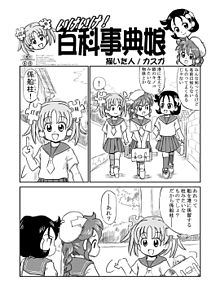Dojinshi
The dōjinshi (同人誌, '&# 39;dōjinshi''?) are self-published manga. These are normally manga fanzines. The term comes from dōjin (同人, 'dōjin'?) or 'the same person' and shi (誌, 'shi'?), sign meaning 'magazine' or 'distribution', thus referring to the fact that the same person who publishes it is the same person who makes the magazine and not a company.
Features
Might be considered hobbyist work, but some are simply small-circulation manga publications. Typically, the dōjinshi artist is based on a current manga or anime, but may include earlier titles or even the original characters of the mangaka. Stories usually consist of a parody or original story featuring the characters from the given manga or anime. There are also dōjinshi about European and American works or films such as Harry Potter, Powerpuff Girls or Star Wars.
At first glance, it seems that hentai stories and illustrations dominate this sector of manga, but many dōjinshi are, in fact, not necessarily geared towards the adult reader, but rather that are created by people who prefer to publish their own comics or are looking to be recruited to enter the market. dōjinshi artists and illustrators, both individuals and members of a "circle", may be mere hobbyists or even professional artists. The group of artists CLAMP started with the dōjinshi[citation needed].
Avid fans of the art of dōjinshi flock to a biannual convention called Comiket (Comic Market) that takes place every summer and winter in Tokyo. There, new and even old dōjinshi are bought, sold, and traded. Due to copyright laws, dōjinshi artists are only allowed to print a few copies of their books. This makes the works of the most sought-after artists and circles something that only the luckiest and quickest can get their hands on before the run runs out.
There is no fixed size for the dōjinshi, and each artist or circle can produce it in the size they want. Prices can range from one dollar to several hundred dollars. This type of art expanded enormously during the 1990s because it promotes a free art form and attracts both talented artists and fans.
Perception
In Western culture, dōjinshi works are often perceived as derivatives of existing works, much like fanfiction. In a way this is true, many dōjinshi works tend to be parodies or alternative stories that use the atmospheres of well-known manga or anime series and even video games. However, others are completely original works in every aspect, from the characters to the story.
Categories
They are distinguished in categories similar to manga: kenzen (for children), shōnen (for young people and adolescents), yaoi (men and male), yuri (female and female) and H “ecchi” or hentai (sexual). Some dōjinshi are original stories that can belong to any category; Another thing that affects a dōjinshi is the popularity of an anime or manga: if it is successful, it will have a dōjinshi; some are innocent stories but others are not. dōjinshi ippan do not contain adult material and are generally suitable for younger audiences.
Contenido relacionado
Alejandro Amenabar
Almohad art
Hapkido
